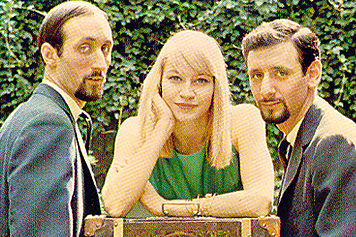Peter, Paul & Mary on hearing the song for the first time, and transforming it into a hit single
Part III of a three-part series. See:
Behind the Song: “Blowing in the Wind” Part I.
Behind the Song: “Blowing in the Wind” Part II.

“One can, I think, say safely that the world fell in love with Bob Dylan’s words,” said Mary Travers , “before they fell in love with his voice.”
Videos by American Songwriter
She was right, of course. But without the hit version of “Blowing In The Wind” which she recorded with Peter, Paul & Mary, the world might have never caught on.
During a 1992 interview I did with the trio for this magazine, Mary said also that unlike some songs, “Blowing In The Wind” was so great that it did not need a “translator” for people to understand it. Yet by recording it with the delivery only they could create – etching the timeless words with soulfully dynamic, great harmony – they effectively did translate it for the world in a huge way. And it worked.
Through the annals of American popular songwriting, it’s undeniable that the greatest champions of songwriters are quite often their fellow songwriters. They are the ones who insist the world pay attention to an unknown genius by making great records of their songs and effectively translating them into common parlance. Words alone amount to little more than hearsay, but an inspired record of a song is direct and powerful evidence of greatness, and tough to deny. Especially when sung by this trio.
Dylan had many champions, including Pete Seeger (who published the lyrics of “Blowing In The Wind” before it was recorded), Joan Baez, who recorded many of his songs, and introduced him to her substantial audience, and others. [More on songwriters championing songwriters to come tomorrow.]
But it was Peter, Paul & Mary who made the first hit with a Dylan song. Like Pete Seeger and John Hammond, who also heard Dylan and recognized his authentic greatness, they recognized a great song when they heard it, and knew the challenge of creating any kind of “protest song” which is not dry, heavy-handed or preachy. They delivered the song with all of Dylan’s poetic biblical grace enhanced with poignant power. Their versions of the song, both live and on record, brought it to the world forever, and made it an iconic American cultural landmark, much more than Dylan’s recording or any other ever could.
Recorded in 1963 for their In the Wind album, it became a hit immediately. But more than a hit. It meant more than entertainment only. Following in the footsteps of Woody Guthrie, they felt, as did Dylan, that the radio airwaves were sacred–a public trust–not to be filled with unworthy songs.
This truth was most evident when they performed the most famously historic version of the song ever. Standing in front of the Lincoln Monument, they sang it at the 1963 March on Washington, in which Martin Luther King, Jr. delivered his “I Have a Dream” speech.
From that moment on, the world knew that Bob Dylan was a songwriter unlike any other. And as he was soon to prove, they were right.
Already established as great purveyors of traditional folk music, they were now letting us know that there were new songwriters creating songs as powerful as Pete and Woody and their other heroes.
In our 1992 interview with Peter, Paul & Mary, they spoke of hearing Dylan for the first time, and the impact of this song:
Mary Travers: When Dylan first arrived on the scene he had a unique voice. Not one that was easily accessible. One can, I think, say safely that the world fell in love with Bob Dylan’s words before they fell in love with his voice. After they’d fallen in love with his words, they began to find his uniqueness in terms of vocal quality.
Peter Yarrow: We first heard [“Blowing in the Wind”] backstage at the Gate of Horn [in New York]. Albert Grossman was managing him at the time, as well as Richie Havens, Gordon Lightfoot, Joan Baez, The Band, Janis Joplin, and the list goes on and on.
Mary: I remember with Dylan, I played him for everybody, including the delivery boy that came to my house. Anybody. Stop and listen to those words. I mean, this was a poet.
Peter: Albert played us [Dylan’s] record, and on that record there were a couple of songs that we hadn’t heard before. One of them was “Don’t Think Twice, It’s All Right.” And the other one was “Blowing in the Wind.”
Mary: Sometimes you need a translator. You don’t need a translator for “Blowing in the Wind.” You just say, “Yes.”Peter: And we felt so strongly about it, that it was the only song that I remember we ever recorded as a single.
Paul Stookey: We each took turns singing the melody, and it was nice. Because there’s a kind of giving, a kind of bending. It’s not pitch, exactly. You can either sing out or you sing out with an invisible touching. That’s what we did.
Mary: That’s the most exciting thing in the group– that kind of ESP you get. You’re listening so carefully that you hear the subtlety of somebody who’s decided tonight to sing the song with a completely different attitude.
Paul: The three of us obviously had a relational capability from the start, and I guess that’s really what it is. And now we even rejoice in it. We have this thing, this confluence, where we decide we all go to bend the jetstream.
Peter: We went in and recorded the song, and it was so, so powerful. It was riveting.









Leave a Reply
Only members can comment. Become a member. Already a member? Log in.